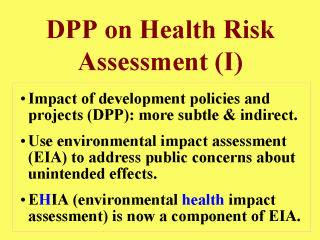 |
The impact of
development policies and projects (DPP) on health risk assessment (RA), unlike that of
public health (PH), is more subtle and indirect but at times equally forceful or
detrimental. The interrelationship among DPP, PH, and RA is through the PH-based
environmental health impact assessment (EHIA), which nowadays becomes an important
component of environmental impact assessment (EIA). EIA is a quantitative process, a set
of activities, or a planning tool used to assess or predict the environmental consequences
of any development project, especially that to be carried out in a developing country. The
main purpose or advantage of conducting an EIA, especially during the early project
planning stages, is to help identify and mitigate a development projectís potential
adverse effects before any costly or irrevocable damage to the environment or the
community takes place. Nowadays, the adverse effects of concern are broadened to include
all aspects of human health including sociocultural well-being, not simply environmental
or economic impacts. This movement is built upon the premise that EIA is conducted to
address public concerns about development projects, and that public concerns frequently
have a focus on physical health, well-being, and the quality of life. EHIA thus becomes an
important component of EIA, the latter is a desired activity, if not a requirement, for
launching a development project or for instituting a development policy. |
